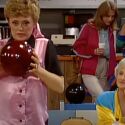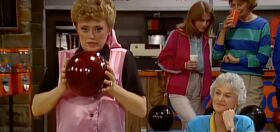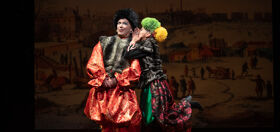
Last night, Fox aired a not-so-very-live version of Jonathan Larson’s 1996 stage musical Rent, a show about poor young New York City artists being pushed out of the East Village by gentrification. FOX’s production got mixed reviews, but during the showing, a handful of queer women on Twitter claimed that Larson actually stole Rent‘s plot from People in Trouble, a 1990 novel about AIDS in New York written by lesbian author Sarah Schulman.
It seems that the ppl are RENT-ing again, so now would be a good time to remind you to read the lesbian novel RENT stole most of its plot from: Sarah Schulman's People in Trouble. Also her book Stagestruck about how RENT ripped her off & what it says about LGBT narratives.
— Morgan M Page (@morganmpage) January 27, 2019
But because RENT was stolen from a queer woman's life and work (Sarah Schulman's PEOPLE IN TROUBLE), and spins the narrative to be centered around straight and largely white people as the heroes of gentrification and AIDS, it's another frustrating example of sanitation & erasure
— Trish Bendix (@trishbendix) January 28, 2019
I can't believe I'm just now finding out that a man stole the plot and characters for RENT from an actual struggling, East Village lesbian author #RENTlivehttps://t.co/1PXXlDUnTr
h/t @trishbendix pic.twitter.com/GD4dTbtZV8— Mary Emily O'Hara (@MaryEmilyOHara) January 28, 2019
“Now wait a second,” you might be saying. “Isn’t Rent based on La Bohème, the 1895 opera composed by Italian Giacomo Puccini?”
And yes, that’s correct. But in her 1998 book Stagestruck: Theater, AIDS, and the Marketing of Gay America, Schulman explained the many ways that Rent seemed to “borrow” from her book.
Before we get to Schulman’s work, let’s briefly compare Rent to La Bohème.
How about we take this to the next level?
Our newsletter is like a refreshing cocktail (or mocktail) of LGBTQ+ entertainment and pop culture, served up with a side of eye-candy.
Separated by nearly 100 years, Rent and La Bohème both cover artists struggling with city romance. In both works, a sweet “girl next door” named Mimi falls in love with her neighbor when she comes over asking him to literally light her candle. In both works, Mimi has a potentially fatal disease — in La Bohème it’s tuberculosis, in Rent it’s HIV — and her male lover falls in love with her despite it.
Both Rent/La Bohème feature similar characters: There’s Roger the songwriter/Rodolfo the poet; Mark the filmmaker/Marcello the painter; their ex-girlfriend Musetta/Maurine; the philosophers Collins/Colline; and Angel/Schaunard a happy-go-lucky musician who appears bearing gifts but later dies.
La Bohème has Mark and Maurine end up together, but that doesn’t happen in Rent. Rent also has Mimi survive, whereas La Bohème has her tragically succumbing to tuberculosis. So, yes, Rent was definitely inspired by La Bohème.

But Schulman’s People in Trouble may have provided the inspiration for Schulman to modernize the story into the modern context of gentrification and HIV activism.
Though Schulman’s book was about a romantic relationship Schulman had with a married woman in the East Village during the ’90s HIV epidemic, The Chicago Tribune explains explains the similarities of both Rent and People in Trouble:
A self-involved East Village performance artist dumps her male lover for a lesbian social activist, leaving the guy in a funk, and creates a performance piece that targets an avaricious landlord and causes a riot. All around them, people are dying of AIDS and neglect. Their best buds, a gay male couple in which one of the guys is HIV positive, is eventually consumed by the disease. His death adds new meaning to the lives of the survivors, who are redeemed by love….
In both works, the male lover and the lesbian interloper meet by accident and end up liking each other and chatting about their common lover.
Both works also involve artists organizing and leading a fiery rebellion against the landlord threatening to evict them. They also both have a friend dying of HIV who inspires them to fight.
Related: Valentina on honoring the past of her role as the saintly Angel in “Rent”
In a 2005 interview, Schulman said, “[In Rent, Larson] has the same triangle between the married couple and the woman’s lover, but he made the straight man the protagonist, whereas in my version he was the secondary character.”
Schulman also claims that the revealing scene in which two characters realize they’re both HIV-positive because of a watch alarm reminding one of them to take medication was taken directly from her book.

The Chicago Tribune says Michael Korie—an opera librettist who worked with Schulman on a stage treatment of People in Trouble—asked Larson if he’d ever read Schulman’s book after he described the plot to Korie:
“I asked Jonathan Larson, `Did you ever hear of People in Trouble?’ and he responded with surprise and said, `It’s funny you should mention that—I didn’t think too many people were familiar with it.’ He said it had influenced his ideas on his own show. I don’t remember the exact words. At the time, I didn’t think anything of it.”
Schulman said she had hoped to turn People in Trouble into a stage production, but she had no luck because theatre producers weren’t receptive to her as a lesbian author with a markedly queer work. However, the Tribune also drops this telling detail:
Schulman didn’t hear about Larson or Rent until 1996, when she went to review the show as a critic for The New York Press, a cultural newsweekly. But, amazingly, Schulman didn’t see the similarities with her own work until it was pointed out to her by a friend.
Another account of Schulman’s Stagestruck says, “the author debunks a lot of the popular mythology surrounding Larson: that he was gay, that he died of an AIDS-related illness, that he lived in the East Village in the ‘80s when Rent is set.”
Schulman never filed a plagiarism lawsuit against Larson, but the question of Rent’s true author apparently rages on.


















Jimmay1979
I thought Larson and Bill Arenson started working on RENT in 1988, which pre dates Ms Schulman’s book by 3 years. The ideas could be similar, but the “story” that has been told by everyone for years is that the relationship dynamic is from Larson’s own life.
Kangol
Actually, the similarities between Sarah Schulman’s novel and Rent are even more extensive than pointed out, and Larson even read Schulman’s novel before working on the musical, but as the Queerty article points out, you can find all of this in her excellent Stagetruck: Theater, AIDS, and the Marketing of Gay America, which is worth reading on literary merit alone, as is her excellent study The Gentrification of the Mind: Witness to a Lost Generation, which explores the effect HIV/AIDS had on urban communities and how straight gentrifiers benefitted from the passing of so many gay men. And given Schulman’s stature as a novelist, critic and activist (in ActUp, etc.), Queerty’s headline comes off as a bit dismissive.
Daniel Villarreal
Thanks for your input! I’m curious, what might’ve been a less dismissive headline, Kangol?
nitejonboy
Bullcrap, I don’t believe this for a second!!!
sfhairy
if she had a case, she would have sued.
MacAdvisor
That’s my thought.
Rock-N-RollHS
I know sarah; she tends toward paranoid narcissism
Bob LaBlah
I tried watching it but found it insufferable and just depressing. Different strokes for different folks.
Dymension
No, they all ripped it off from Puccini’s La Boheme. Only instead of dying from AIDS, in La Boheme she’s dying of consumption (tuberculosis)
Bromancer7
This just in: Lesbian writer plagiarizes Puccini, accuses Rent-creator of plagiarizing what she plagiarized, and then tries to capitalize on his success by writing books about it. Film at 11.
miamifella
No. People in Trouble does not have any plot elements from La Boheme. It was Larson who combined the two stories.
If you have trouble understanding the second act of Rent, read People in Trouble. It goes into more detail about a lot of the confusing plot elements in Rent.
Vardamania
I don’t know anyone who is familiar with all three works who doesn’t think “Rent” is an adaptation of both La Boheme and “People in Trouble” – huge portions of the plot (essentially the entire Maureen-Mark-Joanne love triangle, Maureen starting a riot, the relationship between Angel and Collins, even Collins’s cyber anarchism) are all Schulman.
And, as she herself pointed out, the real problems here are much deeper than whether or not he took her ideas. The real problem is that this groundbreaking musical, much beloved by 90s gays like myself, took a story centering the experiences of queer people and re-centered it to place straight characters in the spotlight. The straight guy in Schulman’s novel (Mark, basically) is not the central narrative voice in the relationship, but in “Rent”, of course, he is.
Worse yet – the changes Larson made to the basic plot of “La Boheme” also reveal his desire to use queer people as tools to make straight people’s lives better. This article suggests that the Angel/Schaunard character dies in both versions – this is untrue. The only character who dies in “La Boheme” is Mimi. Somehow Mimi lives! And lives in a way that is even more maudlin and syrupy and romanticized than Puccini’s! And actually, it’s not just somehow, she is sent back to Earth by Angel. Hope is allowed only to the straight people with HIV, the gay character dies – and almost the only purpose this death serves is so the straight people can realize how important love and life are – and so there’s a dead spirit waiting to send Mimi back to Earth.